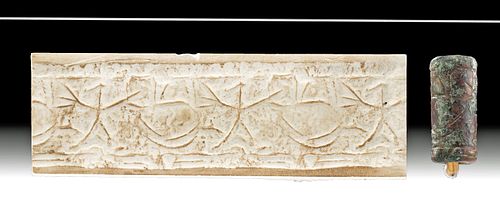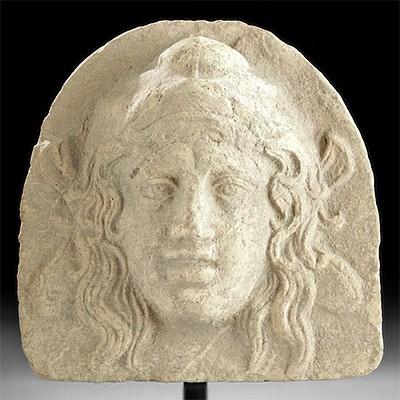Rare Western Asiatic Bronze Cylinder Seal
Lot 85a
About Seller
Artemis Fine Arts
686 S Taylor Ave, Ste 106
Louisville, CO 80027
United States
Selling antiquities, ancient and ethnographic art online since 1993, Artemis Gallery specializes in Classical Antiquities (Egyptian, Greek, Roman, Near Eastern), Asian, Pre-Columbian, African / Tribal / Oceanographic art. Our extensive inventory includes pottery, stone, metal, wood, glass and textil...Read more
Categories
Estimate:
$1,600 - $2,400
Absentee vs Live bid
Two ways to bid:
- Leave a max absentee bid and the platform will bid on your behalf up to your maximum bid during the live auction.
- Bid live during the auction and your bids will be submitted real-time to the auctioneer.
Bid Increments
| Price | Bid Increment |
|---|---|
| $0 | $25 |
| $300 | $50 |
| $1,000 | $100 |
| $2,000 | $250 |
| $5,000 | $500 |
| $10,000 | $1,000 |
| $20,000 | $2,500 |
| $50,000 | $5,000 |
| $100,000 | $10,000 |
| $200,000 | $20,000 |
About Auction
By Artemis Fine Arts
Feb 27, 2020
Set Reminder
2020-02-27 10:00:00
2020-02-27 10:00:00
America/New_York
Bidsquare
Bidsquare : VARIETY SALE | Antiquities & Ethnographic Art
https://www.bidsquare.com/auctions/artemis-gallery/variety-sale-antiquities-ethnographic-art-4920
Around the world & back in time - be amazed at the treasures you will find. Antiquities from Egypt, Greece, Italy and the Near East, Asian, Pre-Columbian, African / Tribal / Oceanic, Native American, Spanish Colonial, Russian Icons, Fine Art, much more! Artemis Fine Arts info@artemisfinearts.com
Around the world & back in time - be amazed at the treasures you will find. Antiquities from Egypt, Greece, Italy and the Near East, Asian, Pre-Columbian, African / Tribal / Oceanic, Native American, Spanish Colonial, Russian Icons, Fine Art, much more! Artemis Fine Arts info@artemisfinearts.com
- Lot Description
Western Asia/Iran, ca. late 3rd to early 2nd millennium BCE. A fascinating and rare bronze cylinder seal with a vertical opening for suspension. Its surface is cast with a standing anthropomorphic figure that appears to hold out a weapon; an ibex or similar ungulate is to one side and a crescent form is below that. It is unclear if this bronze is solid cast or if it is a bronze cap over a bitumen core, as other known bronze cylinder seals are - see for example 1928,1010.261 at the British Museum. It seems likely that it was meant to replicate the beauty of greenstone. Size: 1.1" H (2.8 cm); 2.9" H (7.4 cm) on included custom stand.
Cylinder seals played a major role in the daily life of this region. Known as kishib in Sumerian and kunukku in Akkadian, royals, government officials, scribes, and slaves used them to transact business and send correspondence. They were worn around the neck or wrist and served as a signature and a guarantee, rolled into the moist clay of accounting and governance documents. They also link our modern world to the past - thousands of years ago, people were concerned with security and authenticity for the documents that they used to conduct business. Cylinder seals were a technological solution to a pressing problem, and their scenes are often complex to prevent forgery and identify individuals.
Provenance: private Zaveloff collection, Lakewood, New Jersey, USA, acquired before 2004
All items legal to buy/sell under U.S. Statute covering cultural patrimony Code 2600, CHAPTER 14, and are guaranteed to be as described or your money back.
A Certificate of Authenticity will accompany all winning bids.
We ship worldwide and handle all shipping in-house for your convenience.
#151474Rich patina on surface. Motifs have some light wear but are generally well preserved. Accompanied by a modern clay rollout.Condition
- Shipping Info
-
All shipping is handled in-house for your convenience. Your invoice from Artemis Gallery will include shipping calculation instructions. If in doubt, please inquire BEFORE bidding for estimated shipping costs for individual items.
-
- Buyer's Premium



 EUR
EUR CAD
CAD AUD
AUD GBP
GBP MXN
MXN HKD
HKD CNY
CNY MYR
MYR SEK
SEK SGD
SGD CHF
CHF THB
THB














